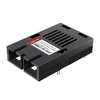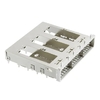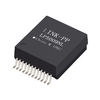News Room/Several Problems Related to 10G Network Lan Transformer Testing
Several Problems Related to 10G Network Lan Transformer Testing
Q: Why does Balun need to be used in 10GBASE-T Lan Transformer spectrum test project?
A: Balun is a differential signal to single-ended transformer. Since each pair of 10GBASE-T Network Transformer signals is differential and the spectrum analyzer can only support single-ended inputs, Balun converts differential signals into single-ended signals that the analyzer can receive. However, due to the Balun will bring additional losses, so you need to use the Balun loss parameters provided by the manufacturer to correct the measurement results.
Q: Why is the 100Base-TX/1000BASE-T Lan Transformer signal eye different from the normal digital eye?
A: 100Base-TX Ethernet Transformer is a 3-level signal. Therefore, the eye diagram is double-layered. It needs to measure the eye diagram of the positive signal and the eye diagram of the negative signal respectively. The 1000Base-T signal is a 5-level signal. Therefore, the normal transmitted signals are superimposed to form a 4-layer eye pattern. Because the eye diagram of 1000Base-T Lan Transformer is already very complicated, the eye pattern test is no longer performed, but some special point signal template tests are performed in the test mode.
Q: How high bandwidth oscilloscopes are needed for signal testing on 10G Ethernet?
A: There are many ways to implement 10G Ethernet. For the 10GBASE-T Lan Transformer standard, due to the use of complex level coding, the signal baud rate is 800M Baud, so testing an oscilloscope with a bandwidth of around 2.5GHz is fine; for XAUI or 10GBASE-CX4 standards, it is Using 4 pairs of 3.125Gbps differential lines for signal transmission, the test recommends using an oscilloscope with more than 8GHz bandwidth, and some standards such as 10GBASE-SR, 10GBASE-LR, 10GBASE-ER, 10GBASE-KR, etc. The actual data transmission rate is 10.3125. Gbps, the fastest signal rising edge is around 30ps. For these tests, an oscilloscope with 16GHz or higher bandwidth is needed.
Q: Why do we have to use vector network analyzers instead of traditional TDR measuring instruments in the test of return loss?
A: In the test of return loss, the DUT must work in the normal transmission mode so that the matching circuit of all circuits is normal. The vector network analyzer measures the return loss by sending a sweep sine wave of different frequencies and receiving the energy reflected by the corresponding narrowband receiving circuit. Therefore, the broadband signal sent by the DUT is filtered by the narrowband receiver of the vector network analyzer. It will not affect the measurement results. The traditional TDR is to generate a wide-band step pulse and receive it in a wide band, so that the signal from the DUT will be received by the TDR device together with the transmitted pulse, so normal testing cannot be performed.




























